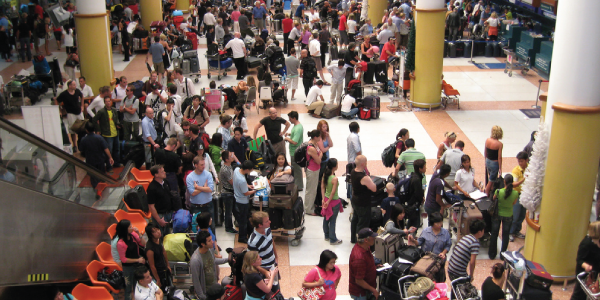Many customers experience the product or service offered by an organization differently than how the organization anticipates. Some of this has to do with where the journey actually begins and ends.
Understanding the customer journey end-to-end helps brands innovate around the experience. But the experience is more than what a customer does after purchase.
Don’t fool yourself!
Airlines may argue their journey is about the actual time in-air for a customer, but as customers, we all know it starts earlier and ends later. And instead of an experience to enjoy, we see it as an experience to endure.

One airline trying to understand the actual journey more for their customers is Virgin Atlantic.
I’ve flown Virgin Atlantic back and forth to London a couple of times in 2014. Just from my observations, I could tell this was a different approach.
For example, in the waiting area before boarding the plane in Heathrow Airport, there is a magazine and newspaper rack well-stocked with complimentary publications for passengers. I snagged a Wired magazine before boarding while other passengers were pretty excited about the European football reading.
It was a simple gesture to make passengers more comfortable. And it’s worth noting it was before we boarded the aircraft.
Virgin Atlantic is investing in many innovative ideas around how to make the transatlantic flight more of an event to experience. They’ve partnered with Microsoft, several media partners, and even live bands to add joy to the journey.
(Unfortunately, the Chicago to London flight is a seasonal one, so I have to fly another airline in April. I’ll miss my pre-boarding magazines!)
When does the journey REALLY begin for customers?
The challenge with understanding any customer journey has a lot to do with how we, as human customers, begin our journey before others can really see it.
For example, when considering a flight, we may be weighing options in our heads well before we begin searching. There’s no way to capture this in data, even with clever survey questions or customer feedback.
Humans process an amazing amount of information which we aren’t always aware we’re processing. This is why it’s not uncommon to create a journey FOR our customers that isn’t really related to the journey our customers are taking.

Here are some ideas to guide your thinking when considering the actual end-to-end experience for your customers.
1. WHAT does your customer really want to do?
In the case of airlines, yes, they want to travel to a certain destination. But they want to do this without changing planes 3 times or waiting at the airport for 16 hours.
2. HOW does your customer come to this conclusion?
This isn’t really about your brand yet. This is about the decision to start the journey at all.
3. WHY does your customer want to interact at all?
Is your customer seeking an experience of luxury or low-cost? Or both? (They want it all!)
4. WHO is your customer?
If you cater to business travelers, for example, then go beyond the obvious like wifi access and business lounges. Consider them as whole people, who are traveling for business but aren’t robots who only talk business.
While these questions may seem obvious to those of us who spend a lot of time focused on customer journey mapping, they aren’t obvious to those in the trenches of marketing teams and product development departments. And that’s ok.
It’s really challenging to think of the true journey when you are asked to only focus on a small piece of it. That’s why reminding ourselves to consider the customers in this way is so critical to an experience to enjoy, not just endure.
Image credits: joncandy, denverkid via Creative Commons license



